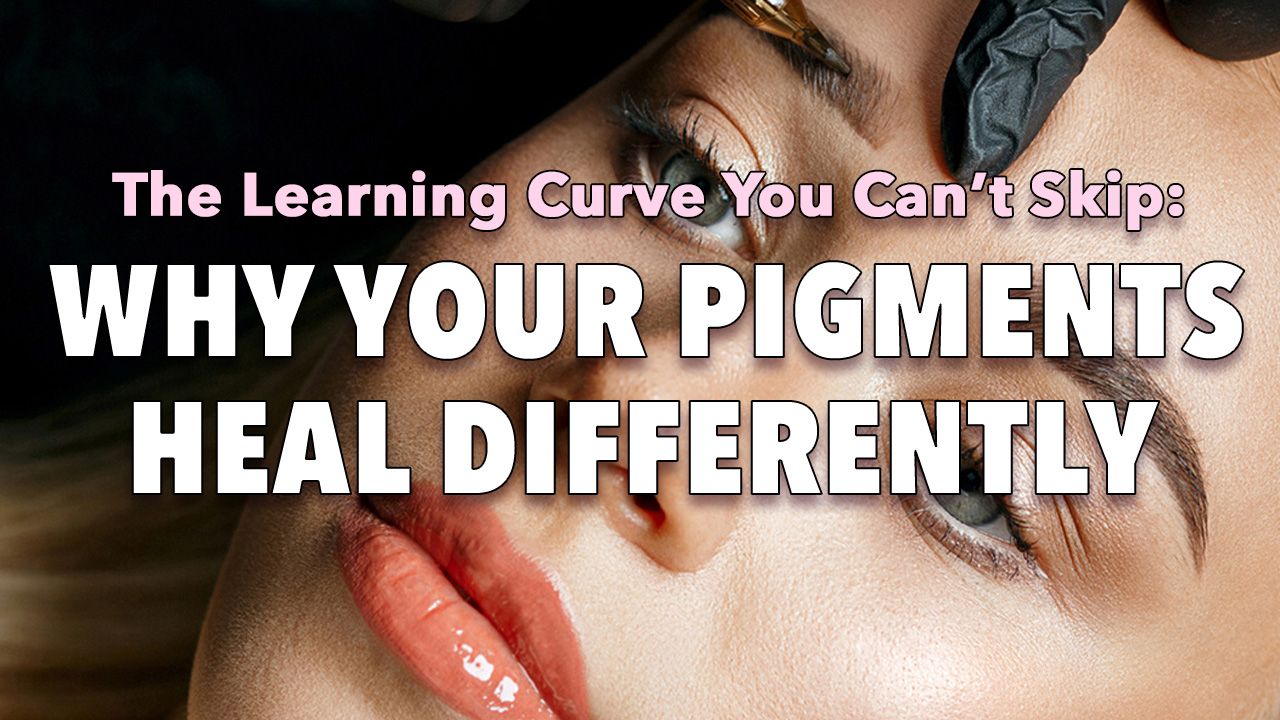
Why Your Pigments Heal Differently: The Learning Curve You Can’t Skip
Oct 17, 2025
Let’s be real, every artist has had a pigment surprise.
That moment when your client’s brows healed cooler than expected… or that eyeliner that looked flawless fresh but turned too dark after healing.
If you’ve ever wondered why pigments heal differently, this episode of Tatter-a-fact® (The Learning Curve Series, Part 3) is your wake-up call.
Because pigments don’t just “act up.” They behave exactly the way their chemistry, skin type, and your technique tell them to. Once you understand that trio, you can stop guessing—and start predicting every healed result.
It all starts with chemistry: Iron Oxides vs Organics
Knowing your pigment base changes everything about how you work.
| Pigment Type | Particle Size | Implantation | Healed Look | Longevity |
Migration Risk |
|---|---|---|---|---|---|
| Iron Oxides (Inorganic) | Larger | Slower, softer implantation | Powdery, natural | Fades sooner (2–5 yrs avg.) | Low |
| Organics (Synthetic/Carbon-based) | Smaller | Fast, strong saturation | Brighter, more vivid | Longer-lasting (4–8 yrs avg.) | Higher (if overworked) |
Iron oxides are mineral-based, reflective, and forgiving. They move slower into the skin, making them ideal for beginners, soft healed results, and delicate skin types.
Organics are carbon-driven, bold, and tenacious. They implant fast, hold color longer, and are perfect for experienced artists who control depth and movement precisely.
The takeaway? There’s no “better” pigment family—just a better match for the skin you’re working on.
“Pigments don’t fail—technique and understanding do.” – Teryn Darling
Carbon Black: The Power (and Responsibility) Inside Organics
Carbon black is the tiniest particle in PMU, and that’s what gives it its rich, intense color. But tiny particles move easily, meaning more risk of migration if you go too deep, use too much pressure, or work on thin skin.
That’s why modern pigment innovation matters.
Formulas like OMG™ Super Black, Black Fusion, and Black Brownie combine iron oxides with carefully balanced carbon black, creating deep saturation without compromising safety.
When you understand what’s inside the bottle, you can pick pigments not by brand hype—but by how they’ll behave in the skin.
Technique Tweaks: How to Work Smarter with Each Type
Switching from Iron Oxides → Organics
-
Lighten pressure—organics implant quickly.
-
Lower your machine speed to avoid over-saturation.
-
Fewer passes—organics pack color fast.
-
Be mindful of oily skin—organics can expand slightly in softer tissue.
Switching from Organics → Iron Oxides
-
Expect slower color build-up.
-
You may need a larger needle grouping (5–8RS or mag).
-
Slightly raise voltage to help pigment move efficiently.
-
Remember: Iron oxides heal 15–25% lighter than they look fresh.
“You can’t tattoo all pigments the same. Each one speaks a different language—and your hand has to listen.” – Teryn Darling
When You Understand Pigments, You Control the Heal
You’ll stop wondering why one pigment lasts forever and another fades too fast. You’ll know it’s because:
-
Carbon-heavy pigments stay longer but cool over time.
-
Titanium dioxide-rich pigments look bright but fade faster.
-
Skin type, depth, and machine control shift the entire outcome.
And when something heals too dark, too gray, or too saturated?
You’ll know how to fix it safely with OMG Li-FT® Saline Removal, instead of covering or compounding the problem.
👉 Li-FT® Saline Lightening Course by Teryn Darling
Keep Learning Beyond the Podcast
Tatter-a-fact® opens the door, Girlz Ink Academy walks you through it.
If this episode lit up your pigment brain, take the next step with the courses that make pigment understanding second nature:
- The Needle & The Prick: How needle groupings, diameters, and tapers change how pigment lays in the skin.
- Machines & Movements: Adjust voltage, stroke, and hand motion to suit each pigment base and skin type.
- Beyond the Epidermis (Color Theory): Understand undertones, modifiers, and fade behavior so you can predict every healed color.
- OMG Li-FT® Saline Removal: Your professional safety net for lightening, lifting, or removing pigment safely.
Education turns frustration into formula. That’s what Girlz Ink Academy is built for.
Real-World Healing Scenarios
| Scenario | Pigment Used | Why It Healed That Way | What to Do Next Time |
|---|---|---|---|
| Brows healed gray | High-carbon organic on cool skin | Carbon outlasted colorants | Use warmer base or inorganic |
| Brows faded too light | Iron oxide on oily skin | Large particles + sebum | Layer slower, consider hybrid |
| Liner migration | Pure carbon on thin skin | Too deep, tiny particles | Use iron-oxide-rich hybrid |
| Too solid heal | Oversaturation with organic pigment | Too many passes | Fewer passes, lighter pressure |
Knowledge doesn’t just fix your mistakes, it prevents them.
FAQ
Q1: How can I tell if my pigment is iron oxide or organic?
Check the ingredients: iron oxides list “CI 77491/92/99,” organics usually list “carbon black” or “CI 77266.”
Q2: Why did my healed brows turn gray?
A carbon-heavy pigment outlasted the colorants. Add warmth or use a hybrid formula next time.
Q3: Should I mix organics and inorganics?
You can—but only if you fully understand how each behaves. Always patch test before working on clients.
Q4: Which is better for new artists?
Iron oxides—they’re forgiving, heal softer, and allow time to refine depth and stretch control.
Ready to connect the science to your technique?
Watch Tatter-a-fact®: Why Your Pigments Heal Differently (The Learning Curve You Can’t Skip) and discover how understanding chemistry and control changes your healed results forever.


